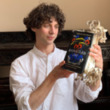I contain multitudes: the microbes within us and a grander view of life
Description
New York Times Bestseller
New York Times Notable Book of 2016
NPR Great Read of 2016
Economist Best Books of 2016
Brain Pickings Best Science Books of 2016
Smithsonian Best Books about Science of 2016
Science Friday Best Science Book of 2016
A Mother Jones Notable Read of 2016
A Bill Gates 'Gates Notes' Pick
MPR Best Books of 2016
Chicago Public Library Best of the Best Books of 2016
Minnesota Star-Tribune Best of the Year
A Kirkus Best Book of the Year
A PW Best Book of the Year
Guardian Best of the Year
Times (London) Best of the Year
Joining the ranks of popular science classics like The Botany of Desire and The Selfish Gene, a groundbreaking, wondrously informative, and vastly entertaining examination of the most significant revolution in biology since Darwin'a 'microbe's-eye view' of the world that reveals a marvelous, radically reconceived picture of life on earth.
Every animal, whether human, squid, or wasp, is home to millions of bacteria and other microbes. Pulitzer Prize-winning author Ed Yong, whose humor is as evident as his erudition, prompts us to look at ourselves and our animal companions in a new light'less as individuals and more as the interconnected, interdependent multitudes we assuredly are.
The microbes in our bodies are part of our immune systems and protect us from disease. In the deep oceans, mysterious creatures without mouths or guts depend on microbes for all their energy. Bacteria provide squid with invisibility cloaks, help beetles to bring down forests, and allow worms to cause diseases that afflict millions of people.
Many people think of microbes as germs to be eradicated, but those that live with us'the microbiome'build our bodies, protect our health, shape our identities, and grant us incredible abilities. In this astonishing book, Ed Yong takes us on a grand tour through our microbial partners, and introduces us to the scientists on the front lines of discovery. It will change both our view of nature and our sense of where we belong in it.
More Details
9780062472595
9780062368621
Table of Contents
From the Book - First U.S. edition.
Similar Titles From NoveList
Similar Authors From NoveList
Published Reviews
Choice Review
When the public thinks of microbes, the context is usually that of disease. Yet as Yong, a science writer for The Atlantic, indicates, life would not exist without the bacterial domains called Bacteria and Archaea. Emphasis is placed on the microbial biome within humans; the human genome contains some 25,000 unique genes, while human microbial flora, largely in the gut, contain some 500 times more. Several are involved in activities such as vitamin production or suppressing the growth of potential pathogens (which really are a tiny minority of microbes). But Yong does not neglect the importance of analogous interactions in nature as a whole. The book is replete with descriptions of host microbe interactions, and even genetic exchange within the microbe population itself--in humans and throughout nature. For example, in Japanese populations, the bacterium Bacteroides (arguably the most common organism within humans) contains genes obtained from another bacterium, which allows it to digest seaweed. Numerous anecdotes of a similar nature, alongside research studies on a variety of subjects, are found throughout the work. The reader is not only informed, but hopefully left with a fascination for the microscopic. Summing Up: Recommended. All readers. --Richard Adler, University of Michigan, Dearborn
Booklist Review
*Starred Review* You are not alone. Smothered in and transformed by microbes, each one of us is a we not a me, insists science-writer Yong. A dazzling and dynamic, pliable and evolving menagerie of microorganisms known as the microbiome or microbiota exists within every human being. Recent estimates figure around 39 trillion microbes (mostly bacteria but also fungi, viruses, and archaea) and 30 trillion human cells share a symbiotic relationship in the typical person. There is no escaping these miniscule creatures. On average, we swallow about a million microorganisms per gram of food we eat and breathe out approximately 37 million bacteria per hour. Banish the stereotype that microbes are bad guys that beget only disease. In our bodies, they guide the immune system, make vitamins, assist in digesting food, degrade chemical toxins, and, very importantly, squeeze out pathogenic bacteria. Yong delves into research on the microbiome across a spectrum of species humans, mice, Hawaiian squid, citrus mealybugs, Mojave woodrats, coral, and giant tube worms, to list just a few. The title of the book, repurposed from Walt Whitman, is indeed apt. Bottom line: don't hate or fear the microbial world within you. Appreciate its wonders. After all, they are more than half of you.--Miksanek, Tony Copyright 2016 Booklist
Publisher's Weekly Review
British science journalist Yong succeeds in encouraging readers to recognize the critical importance of biological microorganisms. He argues that humans must move past the belief that bacteria are bad and need to be eradicated, and adopt a deeper understanding of the positive role they play in the lives of most organisms. Yong makes a superb case for his position by interviewing numerous scientists and presenting their fascinating work in an accessible and persuasive fashion. Throughout, he takes a holistic ecological perspective, contending that it makes no sense to examine bacteria in isolation. As in all ecological systems, context is everything, and the complex community structure of the microbiome does much to determine the effects of various bacteria. Yong demonstrates that this more inclusive view has led to a reconceptualization of how the immune system might work, how microorganisms can shape the development of organ systems, how bacteria might play a role in autism, and how the microbiome may influence an organism's propensity for obesity. He also shows that scientists have moved beyond the theoretical by successfully performing "ecosystem transplants" of human gut microorganisms, and he envisions a future that includes "artisanal bacteria" designed to perform specific tasks. Yong reveals "how ubiquitous and vital microbes are" on scales large and small. (Aug.) © Copyright PWxyz, LLC. All rights reserved.
Library Journal Review
Most people associate bacteria with the bad germs that cause infection and disease, but symbiotic bacteria are crucial to life as we-and many other species-know it. Yong, a science journalist who writes for the Atlantic, examines the bacteria vital to the digestive, immune, and reproductive health of species as diverse as humans, squid, woodrats, and wasps. Even sap-sucking aphids rely on symbiotic microbes to provide them with the amino acids they can't make on their own. He concludes this fascinating study with a look at the brave new world of synthetic biology, where scientists hope one day to bioengineer "designer" bacteria equipped with the right genes to destroy pathogens, eliminate cancer cells, and alter neurotransmitters. (Originally published in Great Britain, this book retains British spelling, punctuation, and expressions.) Yong's readable and entertaining style is appropriate for the nonspecialist, though occasionally the author gets carried away with the use of metaphor and other figurative language. VERDICT Highly recommended for general science readers interested in the complicated relationships between microbes and their hosts.-Cynthia Lee Knight, Hunterdon Cty. Historical Soc., Flemington, NJ © Copyright 2016. Library Journals LLC, a wholly owned subsidiary of Media Source, Inc. No redistribution permitted.
Booklist Reviews
*Starred Review* You are not alone. "Smothered in and transformed by microbes," each one of us is a "we" not a "me," insists science-writer Yong. A dazzling and dynamic, pliable and evolving menagerie of microorganisms—known as the microbiome or microbiota—exists within every human being. Recent estimates figure around 39 trillion microbes (mostly bacteria but also fungi, viruses, and archaea) and 30 trillion human cells share a symbiotic relationship in the typical person. There is no escaping these miniscule creatures. On average, we swallow about a million microorganisms per gram of food we eat and breathe out approximately 37 million bacteria per hour. Banish the stereotype that microbes are bad guys that beget only disease. In our bodies, they guide the immune system, make vitamins, assist in digesting food, degrade chemical toxins, and, very importantly, squeeze out pathogenic bacteria. Yong delves into research on the microbiome across a spectrum of species—humans, mice, Hawaiian squid, citrus mealybugs, Mojave woodrats, coral, and giant tube worms, to list just a few. The title of the book, repurposed from Walt Whitman, is indeed apt. Bottom line: don't hate or fear the microbial world within you. Appreciate its wonders. After all, they are more than half of you. Copyright 2014 Booklist Reviews.
Library Journal Reviews
As Yong's smartly titled work clarifies, we contain hordes of bacteria and other microbes, and they are not all bad. They build our bodies, protect us from disease, help us digest food, and more, and it would be wise to think of ourselves as a mass community of microbiomes rather than individuals. A new tilt to our worldview from an author whose blog, Not Exactly Rocket Science, hosted by National Geographic, receives around 400,000 page views every month.
[Page 91]. (c) Copyright 2016 Library Journals LLC, a wholly owned subsidiary of Media Source, Inc. No redistribution permitted.Library Journal Reviews
Most people associate bacteria with the bad germs that cause infection and disease, but symbiotic bacteria are crucial to life as we—and many other species—know it. Yong, a science journalist who writes for the Atlantic, examines the bacteria vital to the digestive, immune, and reproductive health of species as diverse as humans, squid, woodrats, and wasps. Even sap-sucking aphids rely on symbiotic microbes to provide them with the amino acids they can't make on their own. He concludes this fascinating study with a look at the brave new world of synthetic biology, where scientists hope one day to bioengineer "designer" bacteria equipped with the right genes to destroy pathogens, eliminate cancer cells, and alter neurotransmitters. (Originally published in Great Britain, this book retains British spelling, punctuation, and expressions.) Yong's readable and entertaining style is appropriate for the nonspecialist, though occasionally the author gets carried away with the use of metaphor and other figurative language. VERDICT Highly recommended for general science readers interested in the complicated relationships between microbes and their hosts.—Cynthia Lee Knight, Hunterdon Cty. Historical Soc., Flemington, NJ
[Page 119]. (c) Copyright 2016 Library Journals LLC, a wholly owned subsidiary of Media Source, Inc. No redistribution permitted.Publishers Weekly Reviews
British science journalist Yong succeeds in encouraging readers to recognize the critical importance of biological microorganisms. He argues that humans must move past the belief that bacteria are bad and need to be eradicated, and adopt a deeper understanding of the positive role they play in the lives of most organisms. Yong makes a superb case for his position by interviewing numerous scientists and presenting their fascinating work in an accessible and persuasive fashion. Throughout, he takes a holistic ecological perspective, contending that it makes no sense to examine bacteria in isolation. As in all ecological systems, context is everything, and the complex community structure of the microbiome does much to determine the effects of various bacteria. Yong demonstrates that this more inclusive view has led to a reconceptualization of how the immune system might work, how microorganisms can shape the development of organ systems, how bacteria might play a role in autism, and how the microbiome may influence an organism's propensity for obesity. He also shows that scientists have moved beyond the theoretical by successfully performing "ecosystem transplants" of human gut microorganisms, and he envisions a future that includes "artisanal bacteria" designed to perform specific tasks. Yong reveals "how ubiquitous and vital microbes are" on scales large and small. (Aug.)
[Page ]. Copyright 2016 PWxyz LLC
































